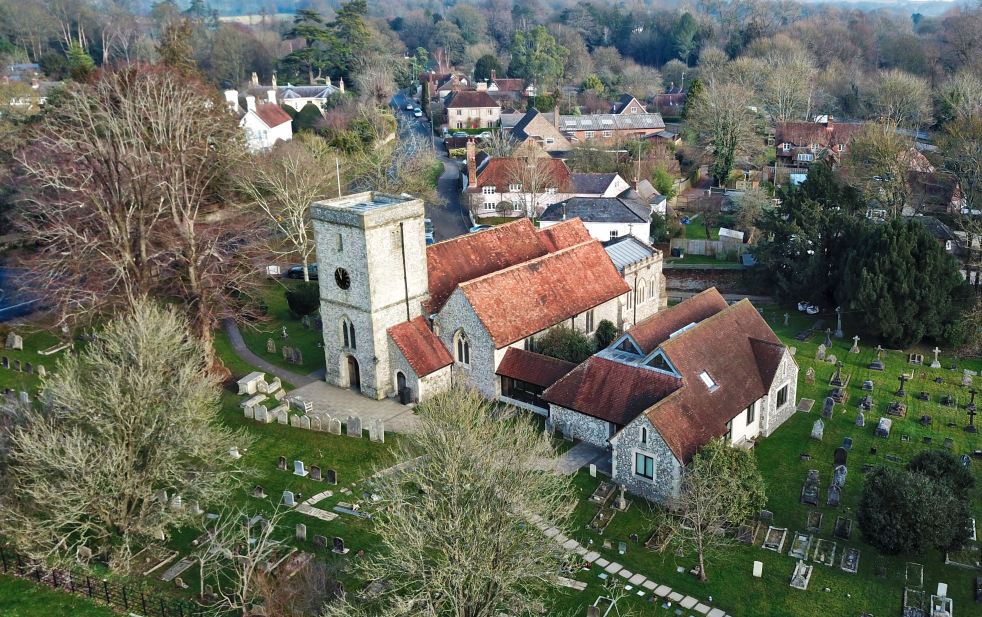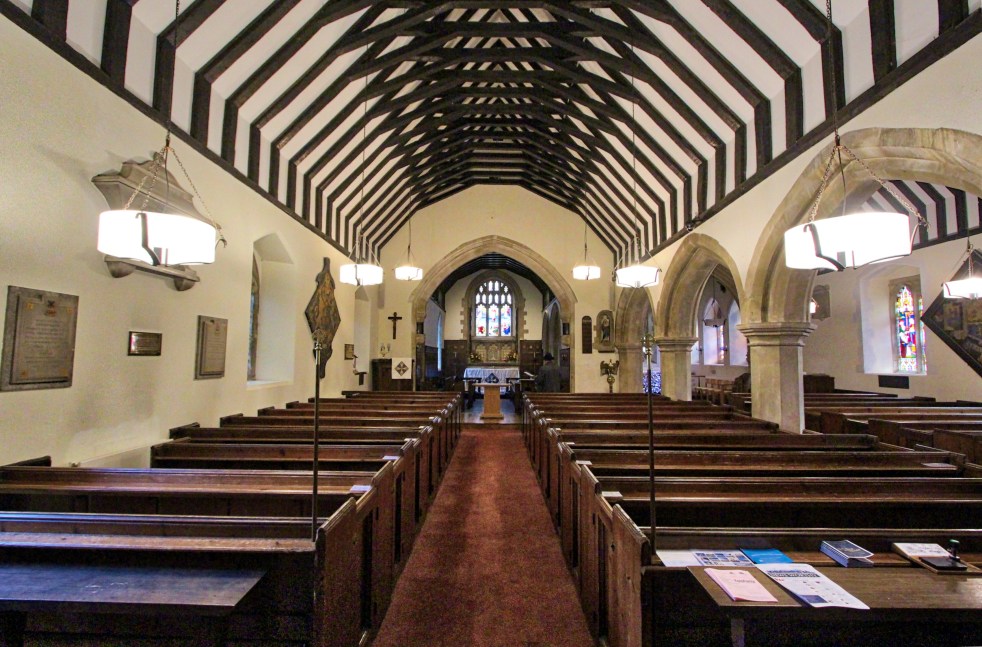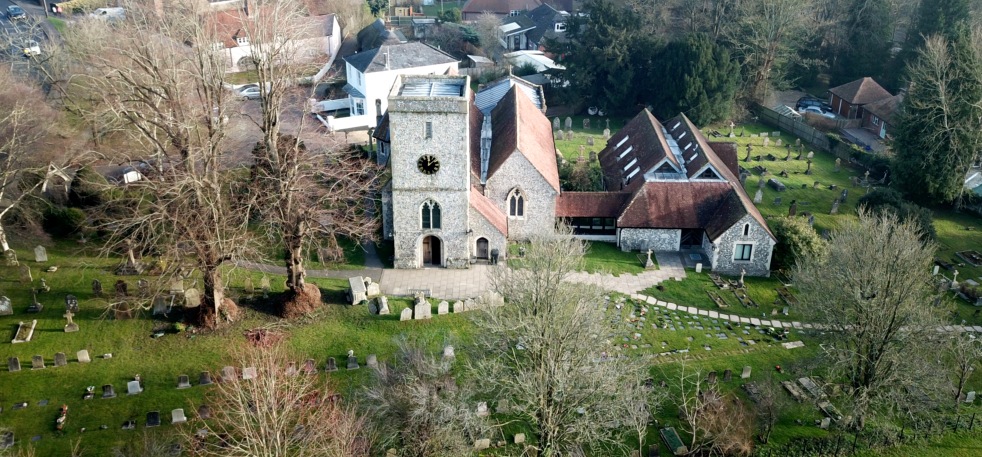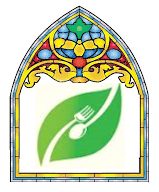This was one of those days that didn’t go as anticipated. Plan A was to visit St Mary’s Church at Itchen Stoke. We had done plenty of research beforehand but, in hindsight we should have wondered just why the guidebooks suggested visiting the church on a sunny day. The reason became clear on our arrival, as there was no electric lighting and with the overcast skies, the stained glass windows did not provide sufficient light to attempt any photography or indeed see very much. After spending far too long looking for non-existent light switches we moved to Plan B which was to brave the traffic jams and carry on into Winchester and visit St. Swithun-upon-Kingsgate, a tiny medieval church built within the fabric of the city walls. On our way however, we passed through the pretty village of Kings Worthy and immediately noticed an interesting flint built church next to the village green which turned out be Plan C, the final choice.
St Mary’s Church, Itchen Stoke

It is worth mentioning our brief visit to Itchen Stoke even though we were unable to do justice to such an interesting Victorian Gothic building. The church is no longer used for worship and, along with several others in Hampshire, is in the care of the Churches Conservation Trust. As we hunted for the elusive light switches, spurred on by the sight of light fittings high in the roof, an elderly lady arrived and told us we were wasting our time, the electricity had been disconnected several years ago. She told us that she was 89, lived locally having had connections to the church for most of her life. She had been a voluntary cleaner there for 20 years, a job that apparently she abruptly ended when a new regime pointed out areas that needed extra attention. She went on to mourn the decline in the state of the building, pointing out the copious bat droppings and areas where theft and vandalism had taken place. She particularly took exception to the altar table being moved to the side wall in order to fully expose a tiled labyrinth in the chancel, a desecration that she said had been carried out by the Labyrinth Society. I hadn’t heard of the organisation and have to say it all sounded a bit mystical and cult-like. However when I got home, I did some research and got a quite different perspective:- www.labyrinthos.net.
We chatted outside the porch for a while and were about to leave when our elderly lady friend pointed down towards the road with the words ‘That’s my husband over there’. I glanced across and saw a gleaming silver Porsche by the Lychgate. When I expressed admiration for the car she responded, “No, he’s over there” pointing to a well maintained grave. “He’s been dead these past 15 years”.
St. Mary’s Church, Kings Worthy
And so, on to another St. Marys Church, this one in Kings Worthy, our unexpected destination of the day. What a contrast. Warm and bright with evidence of a vibrant, active congregation wherever we looked. The notice boards detailed a variety of local events and activities and, at the entrance of the side chapel stood a prayer tree resplendent with fairy lights and written prayers dangling from the branches. Fortunately there was just one copy of David Johnston’s excellent booklet ‘Saints and Pilgrims’ left for sale. After browsing through it for a while I felt it was worth the £9 cost although this is rather more than we usually pay for a church description booklet.



In the year 2000 a group of pilgrims bearing a shepherds crook set off from Winchester to retrace the historic pilgrims route to Canterbury. When they arrived in Kings Worthy, a traditional resting place on the journey, they presented this emblem to the parishioners of St Marys who had it embedded in the church wall.
The route of the Pilgrims Way follows an ancient track from Winchester to Canterbury that dates back to 600-450 BC. Its use by Christian pilgrims began following the canonisation of the murdered Thomas Becket in 1173 after which his shrine in Canterbury became the most important in Christendom. It drew pilgrims from far and wide and it has been estimated that over 100,000 a year were using this route. Inevitably the inclination to make these arduous pilgrimages quickly declined following the 16th century reformation and the subsequent robust discouragement of Catholic practices.

Apart from the medieval roof structure, what we see to day is the result of the 19th century restorations and enlargements

The south aisle looking towards the rear of the church. This section was extended eastward twice in the 19th century (1864 and 1884) as the local population increased. When the proposals for the second extension were being considered, the rector felt it necessary to hold a public meeting with the parishioners to deal with their fears that any additional ornamentation might lead to ‘ritualism’. This was the contentious matter of the day, as it was during the period of the Anglican struggles between High and Low Church.


A medieval treasure, the importance of which has only recently been realised, is in the side chapel. This insignificant 500 year old roundel of stained glass was acquired and fitted during the 1884 restoration and depicts the two missionary bishops, St Swithun and St. Birinus. Just where it originally came from is a mystery.

Considering that there has been a church on this site for over 700 years, the churchyard seems rather small, but that may be because when the building was first constructed there was no churchyard at all and the departed were sent to Winchester for burial. Around a century later some adjacent land was acquired and the rector of the day had it consecrated by a visiting bishop and the first burial took place. Immediately the Abbot of Hyde, who traditionally had the right to bury the dead (and collect the associated fees) lodged a complaint. The ensuing contest became so serious that it was referred to the Pope. Eventually a decision was made in favour of the church, helped by the fact that it was becoming increasingly impractical to transport the growing number of corpses to Winchester, particularly after the Black Death of 1348.
There are some interesting and poignant graves. In 1932 a new slide was provided at the recreation ground and 11 year old Dorothy Holland was one of its first users. Sadly she got a splinter from the wooden structure that led to blood poisoning which, at a time before antibiotics, proved to be fatal. A small statue of a sorrowful girl marks her final resting place.
In 1886 two shipmates, James Parker and Albert Brown were walking back to London from their ship in Southampton and, after a night drinking in the village tavern, bedded down in a farmers hay rick. In the morning James was found with his throat cut and Albert Brown had fled together with James’s meagre savings. The case became notorious overnight and within a year the culprit was caught, tried and hanged. James Parker’s grave is situated to the right of the church by the boundary.
By the fence to the left of the church is a memorial to the lady known locally as “The Woman who lived in a Hole”. Yolanda Span, at one time a successful interpreter, moved to Kings Worthy and set up a smallholding with chickens and goats. Her lifestyle deteriorated after the death of her husband, and in the 1940’s she resorted to living in a 3ft by 7ft hole with a corrugated roof and a floor of old newspapers. It is not clear whether this arrangement was of her own choosing or is evidence of a lack of compassion in the parish.
The Cart and Horses
Following our tour of the church I stayed on for a while in order to capture some overhead photos. At the sight of the drone BQ, as usual, made himself scarce and hurried off to the nearby Cart and Horses tavern despite my often repeated assurances that I am registered, follow all legal requirements and avoid operating the drone over sensitive areas. I rather think he fears being arrested as an accomplice to the reckless endangerment of public safety. But all was well, the sun emerged, photos were taken and after a while I followed him into the welcoming interior of the 250 year old Cart and Horses. To my surprise I found the place already filled with diners and just a single table unoccupied. BQ however, was relaxing at the bar with a freshly brewed coffee chatting to some locals. On discovering he had not made a reservation I hurried back to the dining room and was fortunate in securing the last remaining table.
Personally I found the food to be excellent, the staff efficient and friendly and the charges moderate. I would have been quite happy to award 4 stars except that I could see BQ struggling to make a dent in his gargantuan portion of fish and chips.

The Grange
On our journey back from the pub we called in to see the Grange, a truly impressive building that is now used for opera performances. BQ, an opera lover and a regular at Glyndebourne, was keen to see this relatively new venue. He had, in the past, considered applying for tickets but had been deterred by the prohibitive price of even the cheapest tickets.


Between 1809 and 1816 a modest 17th century brick building once used as a hunting lodge by George, Prince of Wales, was transformed, on the instruction of Henry Drummond, into something more like an ancient Greek temple. The architect, William Wilkins, coated the existing building in cement then added classical façades, including the striking temple front supported on eight gigantic columns. However, before the work was completed the building was sold to Sir Francis Baring, the founder of Barings Bank, the very same bank that gained such notoriety 200 years later when it collapsed following massive losses caused by the rogue trader Nick Leeson. The Grange is still owned by the Baring family, but since 1998 has been leased out to opera companies who have held annual summer festivals there.
BQ’s Inpressions
Lost in the Labyrinth
It was all a bit “Da Vinci” as we first visited the unlit church on the hill on a dull and misty morning. Thankfully the figure that appeared out of the darkness was not “Silas the hooded monk” but a sweet old retainer.
After recovering from the shock, as my eyes became accustomed to the gloom, a real gem of a church became visible “all magnificent artifice but lacking a soul”.
One could only imagine the shock and awe that this building generated at the time of its unveiling for here, in this modest village, was a church with all the extravagant trappings such as the Rose Window and tiled Labyrinth that would usually only be found in more august buildings such as those across the English Channel in Paris with its reputation for high living and glamour. One can only imagine the raised eyebrows of the humble congregation at such an excess of “Popery”.
The Labyrinth is interesting in that it is regarded as a spiritual journey into the centre and back along the only possible route, and must never be confused with a maze in which one can get lost. It is regarded as a tool of meditation and prayer and, although found in many French Cathedrals, it dates back to ancient Crete and Egypt.
In all our visits and blogs spanning nearly two years and around thirty visits we have only found two churches that are no longer active, and which are administered by the churches preservation trust. Interestingly both were built at considerable expense in the 1800’s. Perhaps those Anglo Saxon and Medieval builders knew a lot more about location than those that followed?
Which leads us seamlessly onto St Mary’s at Kings Worthy whose provenance was immediately proclaimed by a Norman porch, but subsequently subsided into a fully serviceable interior from the 1800’s. However those Normans knew instinctively where to situate a place of worship – alongside the village green and shop and a short distance from the pub, and now it responded to its central position as it gave every indication of a busy warm hub to the village.
On entering the church my attention was drawn to an inkpad and rubber stamp that appeared to be for stamping cards for those pilgrims walking from Winchester to Canterbury along the Pilgrims Way. It mischievously reminded me of my youth and the pass-out stamps that bouncers would put on my hand in order for me to re-enter a place of carousing festivities.
With the recent furore against drones I made myself inconspicuous whilst MW surreptitiously went about his business. I hid in the bar of the Cart and Horses rehearsing my denial of any involvement in such activities. Eventually he joined me, upset that I had not reserved a table as the restaurant was filling fast. I refrained from telling him that I was waiting in case he had been apprehended by the law.
The meal and service were excellent, but I must remember to dispense with a starter when in a public house as I was forced to curtail my main course of fish and chips through gluttony.
This was good pub food and, yet again, your intrepid duo had rescued a day from the jaws of disaster particularly as it culminated in a visit to the grand and amazing mansion of The Grange. Regrettably there was no ‘Marriage of Figaro’ but we did meet a lady who was shortly to be married at the venue; well you can’t have everything!
- Our lunch
- Pan –fried scallops with crispy bacon in a garlic and coriander glaze BQ
- Stuffed Moroccan courgette rolls, rolled ribbons of courgette, stuffed with Moroccan spiced brown vegetable rice on mini skewers, with a dressed salad and toasted mixed seeds MW
- Hand-battered Atlantic cod and chips, a large skinless cod fillet with chips and tartar sauce BQ
- Grilled salmon with roasted vegetables on a bed of warm roasted butternut squash, red onion, peppers and baby potatoes with spinach and house dressing MW
- Santa Rita Chilean Cabernet Sauvignon BQ and MW



Another busy fascinating day and a lot to read and take in but very interesting. Enjoyed reading about “sweet old retainer” and her comments about the Labyrinth and pointing out her late husband’s grave. Poses the question, could one have a Porche for a hearse.
St Mary’s Church and churchyard had a lot of interesting things to learn about and it seems those in authority both Roman Catholic and Anglican have changed very little, still arguing with money at the root of the disagreement. Perhaps the Pope should have banged their heads together.
There seems some confusion with the name of the pub being called Horse & Cart; Cart & Horse and Coach and Horses in your account! However it sounded warm and comfortable and the food very plentiful and good.
The Grange was also very impressive and I’m sure it would be wonderful to attend an opera there in the summer.
LikeLike
Another great read. Thank you both. How sad a community/people are not using and enjoying such a lovely building at Itchen Stoke. It should be full of people. Cafe, children indoor play area for winter and wet days. Should be full of noise and laughter. What a waste. I had no idea what a labyrinth was meant to represent. What a beautiful ‘find’. How the past can fascinate. The Grange sure has WOW factor. Great photos MW took from his (dicey) drone – keep it up. I’ll send you my phone number. My son is a lawyer should you end up in cuffs!!
LikeLike